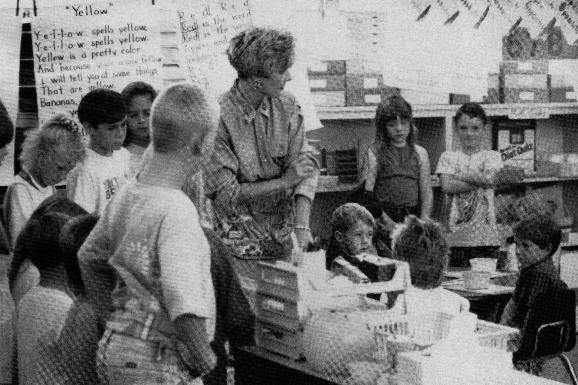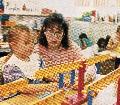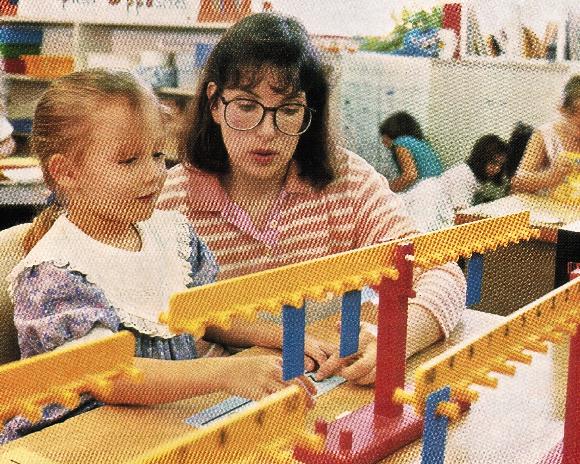
“I like the fact that my students like math—but more important than that is that they love to study—they love to learn.”
In Texas, the general guidelines for kindergarten are that students should be able to compare things, to recognize numbers one through 20, and to be familiar with circles, squares, and triangles.
By the end of kindergarten, most of the Port O’Connor kids are familiar with addition and subtraction of whole numbers, fractions, coordinate graphing, positive and negative integers, solving for one unknown in an algebraic equation, area and perimeter of polygons, symmetry, and place values of numbers into the thousands.
Bob Nielsen, [a former mathematics professor,] a member of the Mathematical Sciences Education Board in Washington, DC, and an assistant to the president of the American Federation of Teachers, has visited the Port O’Connor School twice and is a strong advocate of both the Port O’Connor School and of Dr. Shoecraft’s work.
Nielsen says, “It’s the direction that school mathematics ought to go everywhere. The truth that has emerged is that you don’t have to have a pointed head, long ears, and bifocals to be able to learn math. Port O’Connor has demonstrated that all kids can learn math.
“I hadn’t realized how dramatically things can change until I visited Port O’Connor School. I’m convinced that this stuff is so radically different from the way you and I learned math that the only way to convince people is for them to see it happen—if you haven’t seen it, you can’t believe it.
“There’s something wrong when math is a subject that almost all kids learn to hate—the Port O’Connor School is dramatic proof that it doesn’t have to be that way.” …
He encourages parents and teachers to ask questions about their own math programs in their local areas. “If you walk into the classroom and the kids are having fun, then the school has got the right stuff; if not, then it’s just teaching math the old-fashioned way,” says Nielsen.
Dr. William Kirby, an educational consultant who was the head of the Texas Education Agency for many years, says he thinks the program is “super, because It sets high expectations for kids, and it utilizes teachers with adequate training that believe in themselves.
Dr. Kirby says students, through the use of concrete objects, are actually “experiencing mathematical concepts first hand. They are actively engaged with their hands and their eyes, not just their ears. Too often kids sit passively, listening to a lecture,” he says. “If we’re going to get where we need to be in this country, we need to change xxx
the model that’s existed for the last 200 years of the teacher as merely a dispenser of facts.”
Dr. Kirby is also impressed with Port O’Connor’s “Math Buddies” program because of the team effort it inspires: xxxxxxxxxx
“Sometimes older kids are helping younger kids, and sometimes the reverse is true.”
He says the Port O’Connor School has convinced him that teachers should be “guides, mentors, and assistants to the students.”
“Teachers should be directors of learning—like symphony conductors,” he says. “Not everyone in a symphony gets to sit in the first chair—but everybody participates and has an important role.”
For education reform to work, he says, it must come from local schools, unlike traditional “top down” reform. “Give people at local districts the freedom to be creative,” says Dr. Kirby.
Principal Bratcher is convinced that the math program at the Port O’Connor School is the tip of the iceberg, and teachers in all grades at the school are applying the successful methods used in Mrs. Anderson’s class, such as crossing grade levels and using manipulatives, in teaching other subjects.
“This has really changed the way we do things in our whole school,” says Mrs. Bratcher. “And because Port O’Connor has hardly any student turnover, the long-term success of the school will be easy to monitor,” she says.
So far, with kindergarten students regularly testing out at second and third grade levels, and some as high as junior high levels, the success is fairly obvious. (Italics added.)
The University of Houston at Victoria honored the young mathematicians at the Port O’Connor School in 1989 by offering UHV scholarships to all of the students on the condition they finish junior college. Dr. Shoecraft says the university wanted to acknowledge the important role these students play in making this type of innovative program work.
One Port O’Connor student, Devon Vasquez, wrote President Bush while attending second grade at the Port O’Connor School: “Teachers from all over Texas have come to watch us do our work because they want their kids to do the fun things we do. We would be happy if you came to Port O’Connor, Texas, to our math class so we can show off our brains to you.” (Italics added.)
Next > | New Math Formula | Kindermath | Demonstration | Federal Funding | Inservice Funded | Anyone Can Learn Math | Summer Volunteers | Monster Math | Making Math Fun | Area Leaders | New Math of 90s | Video | MOVE IT! | Math Made Easy | VIPS to View Pgm | Gov. Richards | Richard's Attention | Revolution | Adds Up | Mexico | Letter | Atlanta 2003 | < Back — HOME



